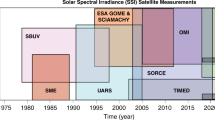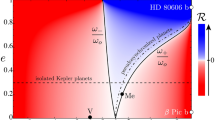Abstract
THE spectrohelioscope of Dr. G. E. Hale1 allows one to observe in the light of a single spectral line the extremely rapid variations occurring on the sun's surface. But this spectral line has to belong to the visible region of the solar spectrum. (H especially is used.) The spectroheliograph on the other hand allows one to photograph solar phenomena in the light of any photographically active spectral line, but it is not able to record the very rapid changes.
This is a preview of subscription content, access via your institution
Access options
Subscribe to this journal
Receive 51 print issues and online access
$199.00 per year
only $3.90 per issue
Buy this article
- Purchase on Springer Link
- Instant access to full article PDF
Prices may be subject to local taxes which are calculated during checkout
Similar content being viewed by others
References
G. E. Hale, Astrophys. J., 70, 265, 1929; 71, 73, 1930; 73, 379, 1931; 74, 214, 1931.
Author information
Authors and Affiliations
Rights and permissions
About this article
Cite this article
ROSENTHAL, A. A New Spectrohelioscope and Spectroheliograph. Nature 132, 350–351 (1933). https://doi.org/10.1038/132350b0
Issue Date:
DOI: https://doi.org/10.1038/132350b0
Comments
By submitting a comment you agree to abide by our Terms and Community Guidelines. If you find something abusive or that does not comply with our terms or guidelines please flag it as inappropriate.



